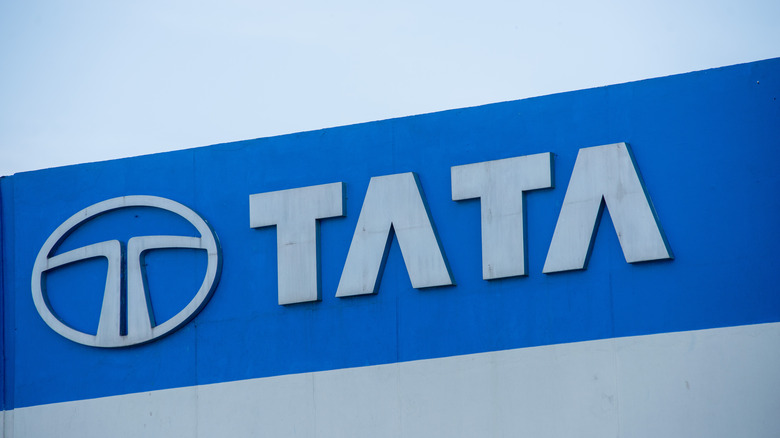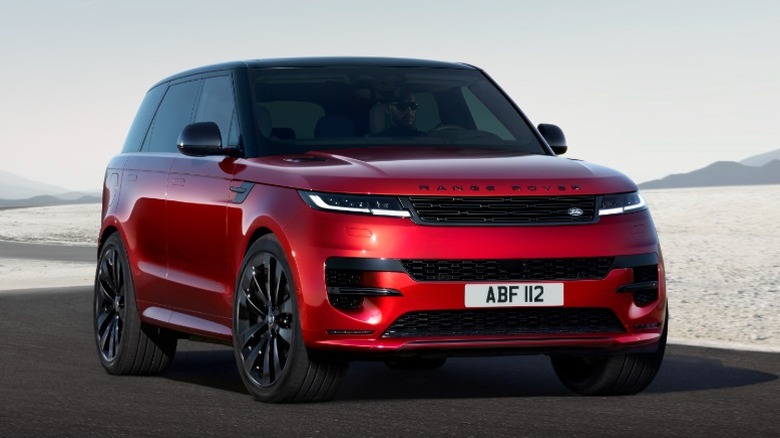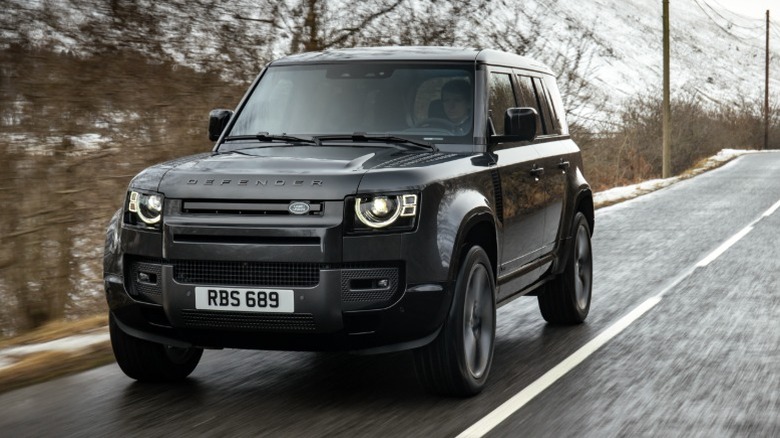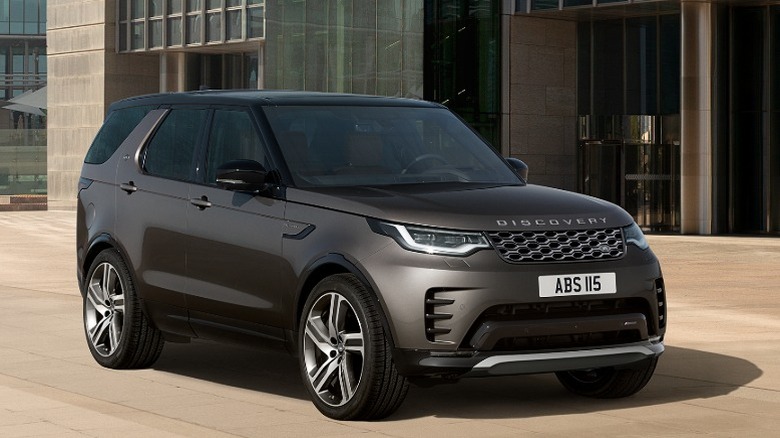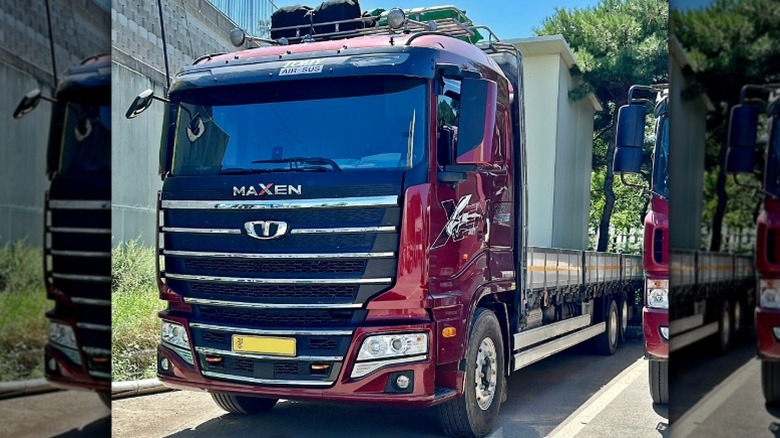5 Car Brands Owned By Tata Motors
Tata Motors may not be a name that comes to mind when you think of car brands, but the Indian company ranks as one of the biggest names in the space. It sits in the top 20 of carmakers based on market capitalization, with its nearly $30 billion market cap placing it among more recognizable names such as Stellantis, Hyundai, and Kia.
Like Stellantis, Tata Motors has several other automakers under its wing. It builds its own EV and gasoline vehicles under the Tata Motors brand, although you likely won't have seen any of these if you live in America. But you've probably noticed — and desired — more than a few vehicles from those other brands under the Tata Motors umbrella. Which ones? Well, the 2025 Range Rover Sport PHEV we reviewed recently is one, as is the dearly departed Jaguar F-Type.
Yes, Tata Motors owns Range Rover and Jaguar, plus a few other brands besides. But it's worth noting that Tata Motors itself is also just a cog in the greater Tata Group conglomerate, which has its fingers in many pies. Tata Power, for example, contributes nearly 15,000 megawatts to the Indian power grid, while Tata Consumer Products is behind some names you may see on supermarket shelves, including Tetley tea and Eight O'Clock coffee.
Jaguar
Let's start with one of the two brands that Tata Motors acquired from Ford in 2008: Jaguar. The famed British automaker was one of two brands that Tata acquired from Ford, the other being Land Rover. As part of the purchase, the Indian firm formed a holding company, Jaguar Land Rover (known as JLR since 2023).
Tata paid a cool $2.3 billion — just over $3.4 billion in 2025 dollars — for the privilege of bringing both firms under its control. Neither firm had necessarily prospered under Ford's ownership, and the company sold both luxury brands as part of an attempt to reduce corporate bloat. Not that Ford got away scot-free, as it still had to contribute $600 million to employees' pension plans as part of the transaction.
Jaguar has had, for the most part, a decent time of it under its Indian overlords. The sporty F-Type debuted under Tata Motors' auspices in 2014 and was a critical darling throughout its run, even earning a 9-out-of-10 score when we tested one in 2023. Other Tata Motors-era offerings such as the F-Pace SUV and XF sedan were also reasonably well-liked, if not necessarily loved, by critics. Unfortunately, recent years have seen things take a turn for the worse at Jaguar, with a poorly received and frankly cringeworthy rebrand putting the automaker in the public eye for all the wrong reasons.
Range Rover
The second half of Tata's massive 2008 purchase was Land Rover, but, like Jaguar, that brand isn't quite what it used to be. In 2023, Jaguar Land Rover became JLR as part of a so-called House of Brands strategy, which also entailed the relegation of the storied Land Rover name in favor of its three vehicle lines. And so, in place of Land Rover, the world received Range Rover, Defender, and Discovery.
What would have been a short list of Tata Motors-owned companies became just that little bit longer as the three former Land Rover models became somewhat standalone marques. Not that Land Rover itself is gone, mind you: as a brand spokesperson told The Sunday Times' Driving in 2023, Land Rover's "spirit is — and will continue to be — a crucial part of our DNA."
Of the three former Land Rover models, Range Rover has the largest lineup, with six — or four, if you don't count SV variants as separate models — luxury SUVs on offer. There's the standard Range Rover (and Range Rover SV), the Range Rover Sport (and Sport SV), the Range Rover Velar, and the Range Rover Evoque, all of which continue the legacy of the original 1970 Range Rover, just with a whole lot more class. The change in branding strategy doesn't seem to have had any impact on the vehicles themselves, thankfully; our Chris Davies reviewed the standard Range Rover in 2024 and liked it enough to give it a SlashGear Editor's Choice award.
Defender
Second among the three former Land Rover nameplates to strike out on its own as a full-fledged brand is Defender. The Land Rover Defender debuted in 1990 and drew inspiration from the original Series I Land Rover, inspired by the off-road legend that was the Willys MB Jeep. After the Series III Land Rover, the company introduced two new models in the 1980s: the One-Ten in 1983 and the Ninety in 1984. These were renamed Defender 90 and Defender 110 in 1990.
However, most of the current Defender lineup bears little resemblance to the simplistic aluminum off-roaders that Land Rover offered throughout the 1990s, 2000s, and 2010s. The automaker discontinued the original Defenders in 2016 due to EU emissions regulations, but Land Rover knew better than to let such a storied heritage die out. It duly introduced all-new premium SUVs bearing the Defender 90 and Defender 110 names in 2020, earning praise from the motoring press. The company even offered a commercial-vehicle Hard Top variant of both with a decidedly utilitarian bent.
These revived models were just the first step, though. The longer-wheelbase Defender 130 debuted in 2022 with the same luxury approach as the previous models. Up next was the brand's first new model since JLR introduced its House of Brands approach: the Defender Octa. This even more off-road-focused SUV debuted in 2025 and impressed us greatly during our first drive. Modern Defenders all come out of JLR's Nitra plant in Slovakia, which opened in 2018.
Discovery
JLR's House of Brands marketing shift in 2023 didn't just elevate the storied Range Rover and Defender names; it also brought the Discovery — hailed by some commentators as a pioneering off-road-capable family SUV — to the forefront, joining its siblings as one of the four JLR marques.
The original Discovery launched in 1989, slotting in between the upmarket Range Rover and the basic Land Rover model that would eventually become the Defender. It was Land Rover's first new model since the Range Rover debuted in 1970, although it took a few years to reach SUV-loving America. In 1994, a Discovery was first available in the U.S., although Land Rover quickly followed up with the Series II in 1999, bringing future updates stateside.
Despite its argued pioneering status, the Discovery and Discovery Sport have not had that great a time in the 2020s. The revived Defender models, built in the same Slovakian plant, have stolen much of the Discovery's thunder, despite a 2021 refresh that introduced new engines and tweaked the Discovery's aesthetics. This 2021 update is essentially the same model available under the Discovery brand, although there has been talk of a reimagined Discovery since around 2024. British automotive outlet Autocar even claimed that a revamped Discovery could draw on minivan elements to more clearly set it apart from the Defender. Only time will tell if JLR and Discovery go down that route, but it would likely be interesting — and almost certainly among the most powerful minivans on the market.
Tata Daewoo Mobility
Last — and some will probably say least — of the Tata Motors brands is Tata Daewoo Mobility, a far cry from the high-end passenger vehicles that are the preserve of Tata's other automotive subsidiaries. However, don't confuse Tata Daewoo with GM Daewoo, now GM Korea; while it has similar roots, Tata's subsidiary has no connection to GM's Far East operations.
That wasn't always the case, though, as you may have guessed given the (once) shared name. When Korean automaker Daewoo went bankrupt in 2000, it had a range of commercial vehicle operations under its belt, including truck and bus divisions. GM acquired Daewoo's car division for $1.2 billion (just over $2.1 billion now) in 2002, but Daewoo's other concerns went to different buyers. Tata first entered talks to acquire the Daewoo Commercial Vehicle Company, as the truck division was officially known, in 2003. The deal went through, and a newly renamed venture, Tata Daewoo Commercial Vehicle, debuted in 2004.
The acquisition worked out quite well for Tata. By 2020, Tata Daewoo was the second-largest commercial vehicle manufacturer in South Korea, and that wasn't the end of it: The next few years saw the Indian-Korean company expand its global operations, establishing a presence in 92 countries and exporting 40% of its total production in 2023. EV plans later prompted a rebrand to Tata Daewoo Mobility in 2024. So, while Tata Daewoo may not be glamorous, it more than holds its own against the more premium brands under Tata's ownership.
